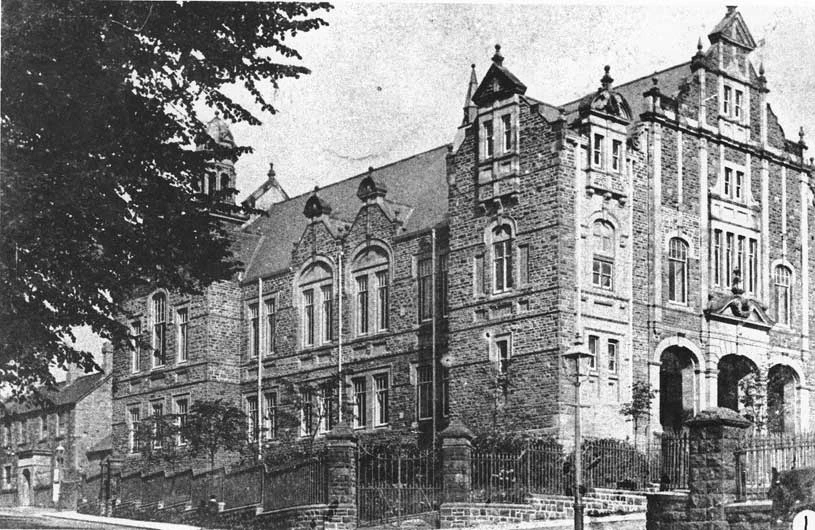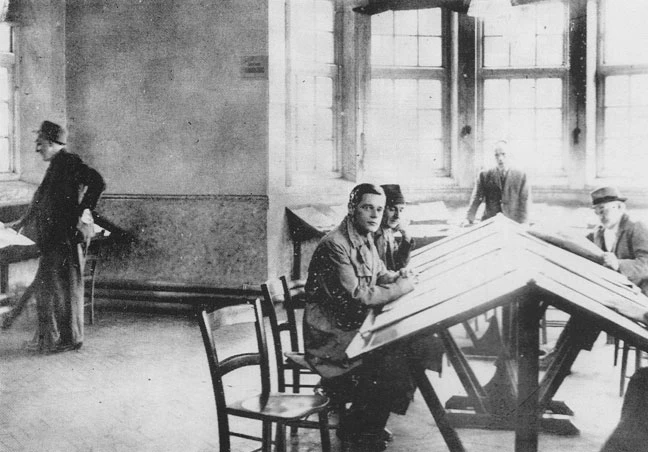Laying foundations: Workmen's Institutes
Workmen's Institutes
Blaenavon Working Men's Institute, early 20th century
Between the 1880s and the 1930s a number of Workmen's Institutes were built in the industrialized townships of south and north-east Wales. Their aim was to provide educational and recreational facilities for workers and their families. They usually housed libraries and reading rooms where daily newspapers were available, but might also include theatres, cinemas and games rooms (snooker, billiards and dominoes were particularly popular). Used for public lectures, political rallies, concerts, dances and eisteddfodau (competitive music and recitation competitions), the Institutes also provided venues where groups and societies could meet and local bands could practise and perform. Some Institute buildings were four or five storeys high and even contained swimming pools!
Oakdale
The Reading Room, Oakdale Institute about 1946
The Oakdale Workmen's Institute served the community based around Oakdale Colliery in Monmouthshire. The first shaft had been sunk in this hitherto relatively unspoilt part of the Sirhowy valley in 1906, and a second — the Waterloo shaft — was sunk four years later. The coal seams proved to be outstanding both in terms of quality of coal and thickness of the seams. Accommodation for the workers and their families was provided in a purpose-built ‘model village’ named Oakdale.
Laying foundations
At the heart of the new village was a Workmen's Institute. Construction work began in 1917 and on 3 July that year a ceremony was held at which two foundation stones were laid. Specially engraved trowels were presented to the two main participants: Harry Blount, on behalf of the workers, and Alfred S. Tallis, Managing Director of the Tredegar Iron and Coal Company, which owned the Oakdale mine. The building was finished the following year when, presumably, a 'topping out' ceremony would have been held to mark the completion of building works.
The building was officially opened on 10 September 1917, and a special key was presented to A S Tallis, representing the mine owners, as a token of the building committee's appreciation for the loan of £10,000 given by the company towards the cost of erecting the building.
A new life at St Fagans
The Oakdale Institute was donated to St Fagans National Museum of History (then called the National Folk Museum of Wales) in 1987. It was dismantled, re-erected and refurbished to its late 1930s appearance and opened to the public in 1995. The two trowels used at the ceremony to mark the laying of the foundation stones were donated to the Museum in the months leading up to the opening by relatives of their original recipients. (One trowel had found its way to the Isle of Wight, while the other was in Swansea.) The building was officially opened by the Rt. Hon. Neil Kinnock, then European Commissioner for Transport, but formerly leader of the Labour Party and MP for the constituency of Bedwellty within which Oakdale was situated. Days before the opening, the engraved key given to the Tredegar Iron and Coal Company was also donated to the Museum.
The 'Stute
The 'Stute is a prize-winning animation made by the animation company Cinetig with pupils from two South Wales schools. It celebrates the crucial role Oakdale Workmen's Institute, Gwent, had in the mining community and draws on oral testimony from the archives at St Fagans.
The 'Stute is a prize-winning animation made by the animation company Cinetig with pupils from two South Wales schools. It celebrates the crucial role Oakdale Workmen's Institute, Gwent, had in the mining community and draws on oral testimony from the archives at St Fagans.

